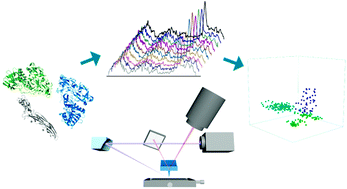Label-free detection of biotoxins via a photo-induced force infrared spectrum at the single-molecular level†
Abstract
There is an increasing urge to investigate facile solutions for monitoring biotoxins, which are a major concern in both the food safety and the anti-terrorism fields. Current techniques, such as immunochromatographic tests (ICT), enzyme-linked immunosorbent assay (ELISA) and mass spectrometry, are still insufficient to satisfy the needs for fast, label-free, and ultra-sensitive detection. Herein, a single-molecular, label-free detection method based on atomic force microscopy was employed to solve the abovementioned problem via a photo-induced force spectrum; typically, three important biotoxins, i.e. abrin toxin (ABR), ricin toxin (RT) and Clostridium perfringens exotoxin (ETX), were used for the demonstration of single molecule detection. The photo-induced force spectrum could be successfully obtained for each of the single protein particles with molecular weights down to 30 kDa. Furthermore, principal component analysis (PCA) was applied for each protein, resulting in a standard PCA identification database. Then, individual components in a mixture of these toxin proteins were well distinguished from each other via matching with the as-built database. Using this strategy, PiFM not only could be used as a powerful tool for single protein detection, but could also be used as a potential tool in protein structural analysis.



 Please wait while we load your content...
Please wait while we load your content...